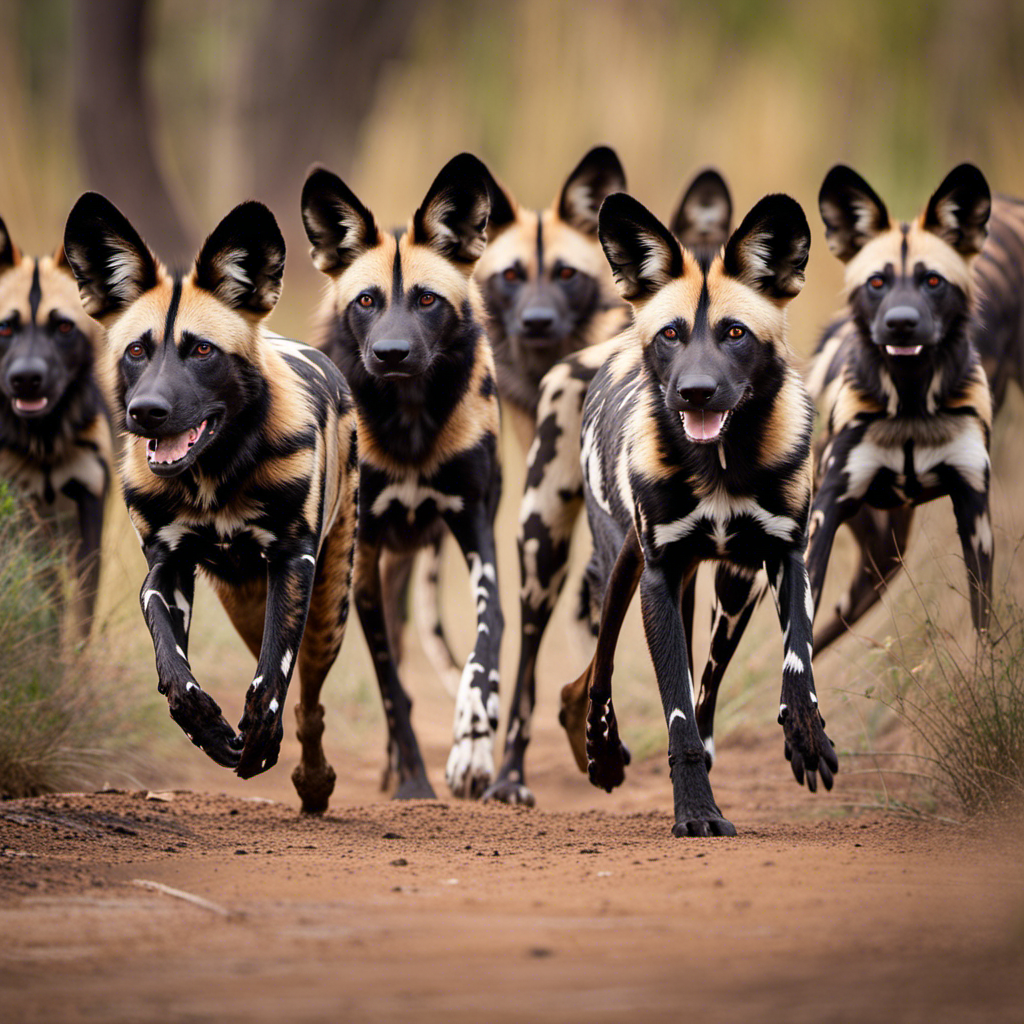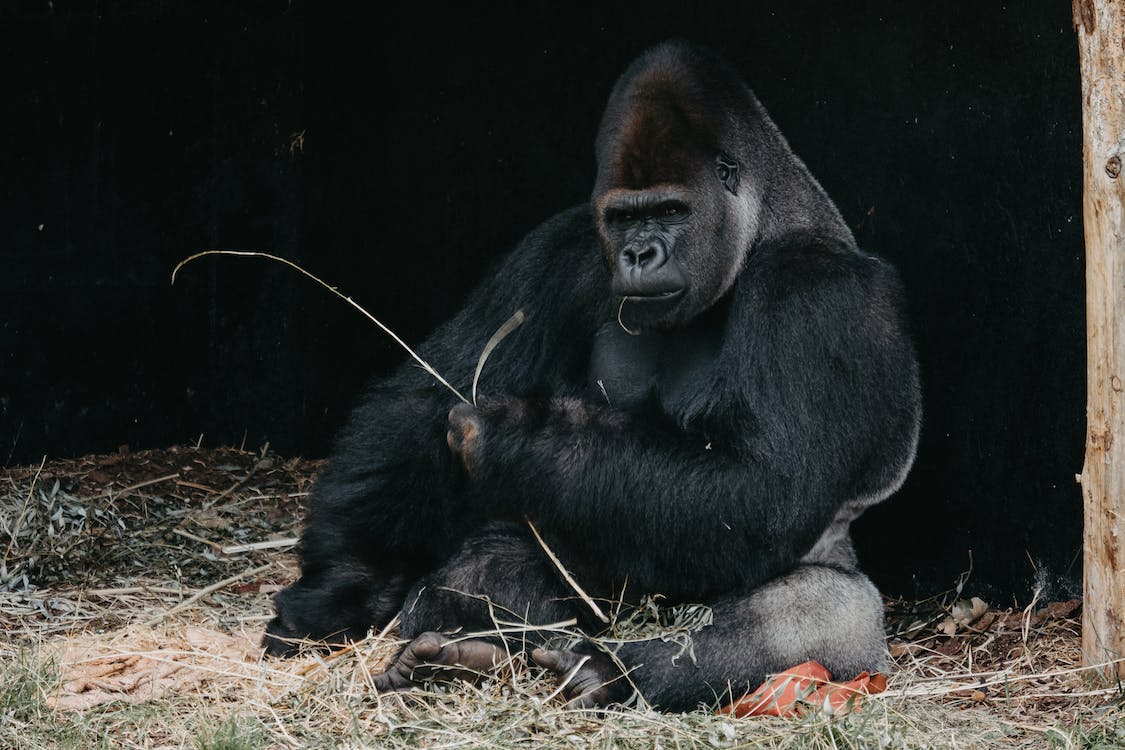Hey there, animal enthusiast! Are you ready to dive into the fascinating world of African wild dogs? These majestic creatures have some incredible secrets to share.
From their unique appearance and size to their highly social nature, there’s so much to learn about these captivating animals.
Get ready to be amazed by their impressive hunting skills and complex communication system.
And don’t worry, we’ll also explore their endangered status and the conservation efforts being made to protect them.
Let’s embark on this thrilling journey together!
Key Takeaways
- African wild dogs have unique coat patterns with a wide range of colors, and no two individuals have the exact same pattern.
- They have a hierarchical social structure with a dominant alpha pair that leads the group and ensures order and cooperation during hunts.
- African wild dogs use unique hunting techniques and demonstrate the power of cooperation and collaboration in their hunting strategies.
- They have one of the largest home ranges among carnivores and play a crucial role in maintaining ecosystem balance, but they are also threatened by habitat loss, human-wildlife conflict, and infectious diseases.
Unique Appearance and Size
African wild dogs are known for their unique appearance and size. These fascinating creatures have distinctive coat patterns that make them easily recognizable in the wild. With their mottled fur, African wild dogs boast a wide range of colors, including shades of brown, black, and white. Their markings are like fingerprints, as no two individuals have the exact same pattern. This makes each one truly special and adds to their sense of belonging in the pack.
The distinctive coat pattern not only serves as a beautiful adornment but also helps with camouflage during hunts in the grasslands. It’s incredible how nature has designed these wild dogs with such intricate and eye-catching features that reflect their unity and harmony within their social groups.
Highly Social Animals
Highly social animals like wild dogs form tight-knit family packs and rely on cooperative hunting strategies. These African Wild Dogs’ social behavior is fascinating and showcases the importance of their social bonds within their packs.
- Social hierarchy: African Wild Dog packs have a dominant alpha pair who lead the group and make decisions for the pack’s well-being. This hierarchical structure ensures order and cooperation during hunts.
- Cooperative hunting: The strong social bonds in these packs enable them to work together efficiently while hunting. They communicate through vocalizations, body language, and even sneezes! By coordinating their efforts, they increase their chances of catching prey successfully.
- Nurturing young: Social bonds are crucial in raising offspring in African Wild Dog packs. All members contribute to caring for the pups, providing food, protection, and teaching them essential survival skills. This communal effort strengthens the pack’s unity and ensures the next generation’s success.
The tight social connections within African Wild Dog packs highlight their remarkable ability to thrive as a cooperative unit, emphasizing the significance of belongingness in their lives.
Impressive Hunting Skills
Impressive hunting skills are showcased by the cooperative strategies employed by these remarkable canines. African wild dogs, also known as African painted dogs or Cape hunting dogs, have developed unique hunting techniques that allow them to efficiently and effectively catch their prey. These highly social animals work together in well-coordinated packs to increase their chances of success. Their teamwork and communication are truly inspiring.
When it comes to prey selection, African wild dogs exhibit a high level of intelligence and adaptability. They have the ability to assess the size and strength of their potential targets, making calculated decisions on which prey to pursue. By focusing on weaker individuals within a group or targeting smaller species, they maximize their chances of a successful hunt.
Through their innovative hunting techniques and strategic prey selection, African wild dogs demonstrate the power of cooperation and collaboration in achieving common goals. Their impressive skills serve as an inspiration for us to embrace teamwork and unity in our own lives, fostering a sense of belonging within our communities.
Complex Communication System
The complex communication system of these canines is key to their successful hunting strategies. African wild dogs, also known as painted wolves, have a unique way of communicating with each other. Through vocalization patterns and scent marking behavior, these social animals are able to coordinate their movements and work together as a cohesive unit.
Table: Communication Methods of African Wild Dogs
| Vocalization Patterns | Scent Marking Behavior |
|---|---|
| High-pitched squeaks | Urine marking |
| Chirps and whistles | Anal gland secretions |
| Growls and snarls | Rubbing against objects |
Their vocalizations include high-pitched squeaks, chirps, whistles, growls, and snarls. These different sounds allow them to communicate various messages such as danger alerts or rallying cries during hunts. Additionally, they use scent marking behavior by urinating on objects or releasing anal gland secretions to leave behind territorial markers.
Large Range and Habitat
You’ll be amazed by the large range and diverse habitat that these painted wolves occupy. African wild dogs, also known as painted wolves, are found in various regions across Africa. Their adaptability allows them to thrive in a variety of environments, from open grasslands to dense forests.
Here are some fascinating facts about their range and habitat:
- Vast Distribution: African wild dogs can be found in 39 countries throughout sub-Saharan Africa.
- Wide Home Range: They have one of the largest home ranges among carnivores, spanning up to 900 square kilometers.
- Ecological Importance: These animals play a crucial role in maintaining ecosystem balance by regulating herbivore populations.
- Conservation Challenges: Unfortunately, African wild dogs face numerous threats such as habitat loss, human-wildlife conflict, and infectious diseases.
Fascinating Pack Dynamics
Joining a pack of painted wolves means experiencing the fascinating dynamics of their social structure. These African wild dogs, also known as painted wolves, have a complex pack hierarchy that determines the roles and responsibilities of each member. In this close-knit community, cooperation is key to survival. The table below illustrates the different positions within the pack and their corresponding duties:
| Position | Description | Responsibilities |
|---|---|---|
| Alpha Male | Leader of the pack | Makes important decisions and protects the group |
| Alpha Female | Second in command | Leads hunts and cares for newborn pups |
| Subordinate | Lower-ranking members | Assist with hunting and taking care of the alpha pair |
| Pups | Young members | Learn from older individuals and play an essential role |
The pack’s cooperative hunting strategies are truly remarkable. They work together as a team to bring down prey much larger than themselves, utilizing tactics such as encircling, chasing, and exhaustion. This teamwork ensures that every member has a chance to eat and strengthens their bond as a unified family. Joining a painted wolf pack means embracing collaboration, loyalty, and belonging to something greater than yourself – a true testament to the power of unity in nature’s incredible tapestry.
Endangered Status and Conservation Efforts
Discovering the endangered status of painted wolves will make you realize the importance of conservation efforts. These magnificent creatures are facing numerous threats that put their survival at risk. By actively participating in wildlife conservation, you can help protect these unique and beautiful animals for future generations to enjoy.
Here are some reasons why conserving endangered species like painted wolves is crucial:
- Preserving biodiversity: Each species plays a vital role in maintaining a balanced ecosystem.
- Supporting local communities: Conservation efforts often involve working with local communities, providing them with sustainable livelihoods.
- Protecting habitats: By preserving natural habitats, we ensure the survival of not only painted wolves but also countless other species.
- Promoting ecological tourism: Conservation initiatives create opportunities for responsible tourism, benefitting both wildlife and local economies.
- Inspiring future generations: Through education and awareness programs, we can inspire young minds to become passionate about protecting our planet’s precious biodiversity.
Together, we can make a difference and secure a better future for all endangered species through dedicated wildlife conservation efforts.
Surprisingly High Success Rate in Hunting
Did you know that painted wolves have a surprisingly high success rate in their hunting endeavors? These African wild dogs are masterful hunters, employing unique techniques and strategies to secure their prey. With an average success rate of around 80%, they are among the most successful predators in the animal kingdom.
To visualize their hunting prowess, imagine a pack of African wild dogs working together like a well-oiled machine. In the table below, you can see how each member plays a vital role in the hunt:
| Role | Description | Example |
|---|---|---|
| Leader | Leads the pack | Decides on the target |
| Navigator | Directs the chase | Tracks and follows scent |
| Chasers | Run alongside prey | Tire out and exhaust prey |
| Ambushers | Wait for prey to pass by | Pounce from hiding spots |
Their remarkable teamwork, combined with strategic planning and coordination, allows them to bring down larger prey such as antelopes or wildebeests. This high success rate ensures their survival as a species and reinforces their position as top predators in their ecosystem. Being part of this efficient hunting team must be truly thrilling!
Matriarchal Pack Structure
The painted wolf pack is led by a dominant female, known as the alpha or matriarch. She is a symbol of matriarchal leadership and female dominance. Here are three fascinating facts about this remarkable pack structure:
- Unity: The matriarch ensures unity within the pack, creating a sense of belonging and cooperation among its members. Through her guidance and nurturing nature, she fosters a strong social bond that strengthens the entire group.
- Decision-making: As the leader, the matriarch plays a vital role in decision-making processes for the pack. Her wisdom and experience guide important choices such as hunting strategies, territory allocation, and raising young ones.
- Succession: When the matriarch ages or passes away, her daughters often succeed her as leaders of the pack. This seamless transition ensures continuity in their social structure and allows for new generations to carry on their legacy of strong female leadership.
Witnessing this unique form of female power is awe-inspiring; it’s an extraordinary example of how collaboration and support can lead to collective success within a community.
Cooperative Parenting and Pup Rearing
Take a moment to appreciate the incredible teamwork and dedication involved in raising pups within the painted wolf pack. The co-parenting dynamics of these magnificent creatures are truly remarkable. As the pups grow, they go through various stages of development, each requiring different levels of care and guidance. Let’s explore these stages in a table format:
| Pup Development Stages | Co-Parenting Dynamics |
|---|---|
| Newborn | Both parents provide round-the-clock attention, ensuring warmth and nourishment for their newborns. They take turns guarding the den against potential threats. |
| Exploration | The whole pack takes on an active role in teaching the curious pups about their environment. Older siblings play with them, while adults monitor from a distance to ensure safety. |
| Hunting Training | The experienced members of the pack teach hunting skills by engaging in mock hunts with the growing pups, boosting their confidence and fostering independence. |
Witnessing this harmonious co-parenting among wild dogs demonstrates how collective effort leads to successful pup rearing. It instills a sense of belonging within both the individual wolves and the entire pack, creating a thriving community that ensures future generations’ survival.
Frequently Asked Questions
How Do African Wild Dogs Communicate With Each Other?
African wild dogs communicate with vocalizations and body language. They use a variety of sounds, such as barks, whines, and growls, to convey different messages. Additionally, their movements and postures play a crucial role in expressing emotions and intentions.
What Are the Main Factors Contributing to the Endangered Status of African Wild Dogs?
Human impact, such as loss of habitat, is a major factor contributing to the endangered status of African wild dogs. We must recognize our role in their decline and work together to protect these incredible creatures and their habitats.
How Do African Wild Dogs Collaborate and Cooperate During Hunting?
When African wild dogs hunt, they collaborate and cooperate in amazing ways. Their strategies and behavior are truly fascinating. Let’s dive into the world of these incredible animals and discover how they work together to succeed.
Are African Wild Dogs More Successful in Hunting Than Other Predators in Their Habitat?
African wild dogs are renowned for their unique hunting techniques. Compared to other predators in their habitat, they have a higher success rate in hunting. Their coordinated efforts and strategic tactics make them formidable hunters.
How Do African Wild Dogs Rear and Care for Their Pups in Their Pack Structure?
When it comes to African wild dogs, their pack structure plays a crucial role in rearing and caring for their pups. From the development of the pups to their socialization, these dogs have unique methods that foster a strong sense of belonging within the pack.
Conclusion
So, now you know all about African wild dogs!
These fascinating creatures are not only unique in their appearance and size but also highly social animals with impressive hunting skills.
Their complex communication system and large range make them even more intriguing.
Sadly, they are endangered, but conservation efforts are being made to protect them.
It’s amazing how successful they are in hunting, thanks to their matriarchal pack structure and cooperative parenting.
With such incredible traits, African wild dogs truly embody the wonders of nature.
Keep exploring and marveling at the extraordinary world around us!





